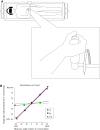Motion sickness: more than nausea and vomiting
- PMID: 24961738
- PMCID: PMC4112051
- DOI: 10.1007/s00221-014-4008-8
Motion sickness: more than nausea and vomiting
Abstract
Motion sickness is a complex syndrome that includes many features besides nausea and vomiting. This review describes some of these factors and points out that under normal circumstances, many cases of motion sickness go unrecognized. Motion sickness can occur during exposure to physical motion, visual motion, and virtual motion, and only those without a functioning vestibular system are fully immune. The range of vulnerability in the normal population varies about 10,000 to 1. Sleep deprivation can also enhance susceptibility. Systematic studies conducted in parabolic flight have identified velocity storage of semicircular canal signals-velocity integration-as being a key factor in both space motion sickness and terrestrial motion sickness. Adaptation procedures that have been developed to increase resistance to motion sickness reduce this time constant. A fully adequate theory of motion sickness is not presently available. Limitations of two popular theories, the evolutionary and the ecological, are described. A sensory conflict theory can explain many but not all aspects of motion sickness elicitation. However, extending the theory to include conflicts related to visceral afferent feedback elicited by voluntary and passive body motion greatly expands its explanatory range. Future goals should include determining why some conflicts are provocative and others are not but instead lead to perceptual reinterpretations of ongoing body motion. The contribution of visceral afferents in relation to vestibular and cerebellar signals in evoking sickness also deserves further exploration. Substantial progress is being made in identifying the physiological mechanisms underlying the evocation of nausea, vomiting, and anxiety, and a comprehensive understanding of motion sickness may soon be attainable. Adequate anti-motion sickness drugs without adverse side effects are not yet available.
Figures





References
-
- Anker AR, Sadacca BF, Yates BJ. Vestibular inputs to propriospinal interneurons in the feline C1–C2 spinal cord projecting to the C5–C6 ventral horn. Exp Brain Res. 2006;170:39–51. - PubMed
-
- Arshian MS, Puterbaugh SR, Miller DJ, Catanzaro MF, Hobson CE, McCall AA, Yates BJ. Effects of visceral inputs on the processing of labyrinthine signals by the inferior and caudal medial vestibular nuclei: ramifications for the production of motion sickness. Exp Brain Res. 2013;228:353–363. - PMC - PubMed
-
- Balaban CD. Vestibular nucleus projections to the parabrachial nucleus in rabbits: implications for vestibular influences on the autonomic nervous system. Exp Brain Res. 1996;108:367–381. - PubMed
-
- Balaban CD. Neural substrates linking balance control and anxiety. Physiol Behav. 2002;77:469–475. - PubMed
-
- Balaban CD, Jacob RG. Background and history of the interface between anxiety and vertigo. J Anxiety Disord. 2001;15:27–51. - PubMed
Publication types
MeSH terms
LinkOut - more resources
Full Text Sources
Other Literature Sources
Medical

